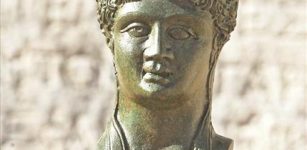Ancient Egyptians Invented Toothpaste
Ellen Lloyd - AncientPages.com - When did people start brushing their teeth? It may come as a surprise, but brushing teeth was a rather common practice in some parts of the ancient world.
The world’s oldest-known recipe for toothpaste comes from ancient Egypt in fact. When discovered, the Egyptian toothpaste formula from the 4th century AD caused a sensation among dentists who described it as an advanced recipe “ahead of its time”.
Egyptians are believed to have started using a paste to clean their teeth around 5000 BC before toothbrushes were invented. Ancient Greeks and Romans are known to have used toothpastes, and people in China and India first used toothpaste around 500BC.
World’s oldest toothpaste recipe caused a sensation
The world’s oldest toothpaste recipe was found in a collection of papyrus documents at the National Library in Vienna, Austria. In black ink (now faded after 1,500 years) made of soot and gum arabic mixed with water, an ancient Egyptian scribe has carefully written down a recipe ‘for white and perfect teeth’.
When mixed with saliva in the mouth, it forms a "clean toothpaste".
According to the document, written in the fourth century AD, the ingredients needed for the perfect smile are one drachma of rock salt - a measure equal to one-hundredth of an ounce - two drachmas of mint, one drachma of dried iris flower and 20 grains of pepper, all of them crushed and mixed together.
The result is a pungent paste which one Austrian dentist who tried it said made his gums bleed but was a "big improvement" on some toothpaste formulae used as recently as a century ago.
The discovery of the formula caused a sensation among Austria's normally sedate dentists when it was disclosed at a dental congress in Vienna.
Dr. Heinz Neuman, who attended the meeting where the recipe was unveiled, said: "Nobody in the dental profession had any idea that such an advanced toothpaste formula of this antiquity existed."
On trying it himself, he said: "I found that it was not unpleasant. It was painful on my gums and made them bleed as well, but that's not a bad thing, and afterwards my mouth felt fresh and clean. I believe that this recipe would have been a big improvement on some of the soap toothpastes used much later."
Ancient people had the same problems with oral hygiene
Ancient kinds of toothpaste were used to treat some of the same concerns that we have today – keeping teeth and gums clean, whitening teeth and freshening breath. The ingredients were however very different and varied. Ingredients used included a powder of ox hooves' ashes and burnt eggshells, that was combined with pumice.
The Greeks and Romans favored more abrasiveness and their toothpaste ingredients included crushed bones and oyster shells. The Romans added more flavoring to help with bad breath, as well as powdered charcoal and bark. The Chinese used a wide variety of substances in toothpastes over time that have included ginseng, herbal mints, and salt.
See also:
Ancient Egyptian Men Used Eye Makeup For Many Reasons
Ancient Egyptians Played Bowling 5,000 Years Ago
The development of toothpaste in more modern times started in the 1800s. Early versions contained soap and in the 1850s chalk was included. Betel nut was included in toothpaste in England in the 1800s, and in the 1860s a home encyclopedia described a home-made toothpaste that used ground charcoal.
Until after 1945, toothpastes contained soap. After that time, soap was replaced by other ingredients to make the paste into a smooth paste or emulsion - such as sodium lauryl sulphate, a common ingredient in present-day toothpaste.
Written by - Ellen Lloyd – AncientPages.com
Copyright © AncientPages.com All rights reserved. This material may not be published, broadcast, rewritten or redistributed in whole or part without the express written permission of AncientPages.com
Expand for referencesMore From Ancient Pages
-
 Unexpected Archeogenetic Study Results Obtained In Graves Of Mödling And Leobersdorf, Lower Austria
DNA | Jan 16, 2025
Unexpected Archeogenetic Study Results Obtained In Graves Of Mödling And Leobersdorf, Lower Austria
DNA | Jan 16, 2025 -
 Mysterious Undeciphered Ripley Scroll And Its Connection To The Philosopher’s Stone
Featured Stories | Mar 26, 2025
Mysterious Undeciphered Ripley Scroll And Its Connection To The Philosopher’s Stone
Featured Stories | Mar 26, 2025 -
 Patara -‘The Chosen City’ Of Ancient Lycia
Civilizations | Sep 15, 2015
Patara -‘The Chosen City’ Of Ancient Lycia
Civilizations | Sep 15, 2015 -
 Siege Of Masada – The Last Stand Against The Roman Empire
Civilizations | Mar 27, 2017
Siege Of Masada – The Last Stand Against The Roman Empire
Civilizations | Mar 27, 2017 -
 Mabon Festival And The Autumn Equinox Celebrated By Pagans
Ancient Traditions And Customs | Sep 19, 2024
Mabon Festival And The Autumn Equinox Celebrated By Pagans
Ancient Traditions And Customs | Sep 19, 2024 -
 2,000-Year-Old Stringed Instrument Found In Vietnam
Archaeology | Feb 22, 2023
2,000-Year-Old Stringed Instrument Found In Vietnam
Archaeology | Feb 22, 2023 -
 Ancient Disc-Shaped Copper Ingots Found In Shipwreck At Bulgaria’s Sea Coast
Archaeology | Apr 28, 2020
Ancient Disc-Shaped Copper Ingots Found In Shipwreck At Bulgaria’s Sea Coast
Archaeology | Apr 28, 2020 -
 1,700-Year-Old Statue OF Greek God Pan Unearthed In Istanbul
Archaeology | Jun 9, 2023
1,700-Year-Old Statue OF Greek God Pan Unearthed In Istanbul
Archaeology | Jun 9, 2023 -
 Bronze Age Human Remains Uncovered In Dorset During Excavation Of Iron Age Settlement
Archaeology | Jul 10, 2023
Bronze Age Human Remains Uncovered In Dorset During Excavation Of Iron Age Settlement
Archaeology | Jul 10, 2023 -
 Advanced Ancient Technology – Talos A Greek Robot Created By The God Of The Forge
Featured Stories | Jun 28, 2014
Advanced Ancient Technology – Talos A Greek Robot Created By The God Of The Forge
Featured Stories | Jun 28, 2014 -
 Tarascan Indians: Intriguing Pre-Columbian Civilization Of Artists, Warriors And Skilled Metallurgists
Civilizations | Sep 9, 2021
Tarascan Indians: Intriguing Pre-Columbian Civilization Of Artists, Warriors And Skilled Metallurgists
Civilizations | Sep 9, 2021 -
 Angerona – Goddess Of Silence During Cosmic Crises And Protector Of Ancient Rome
Featured Stories | Feb 15, 2019
Angerona – Goddess Of Silence During Cosmic Crises And Protector Of Ancient Rome
Featured Stories | Feb 15, 2019 -
 Did Climate Change End The Akkadian Empire?
Civilizations | Jul 17, 2019
Did Climate Change End The Akkadian Empire?
Civilizations | Jul 17, 2019 -
 On This Day In History: Samuel Morey Patents The Internal Combustion Engine – On April 1, 1826
News | Apr 1, 2017
On This Day In History: Samuel Morey Patents The Internal Combustion Engine – On April 1, 1826
News | Apr 1, 2017 -
 Ancient European Languages Shed Light On A Great Migration And Weather Vocabulary
Archaeology | Aug 14, 2023
Ancient European Languages Shed Light On A Great Migration And Weather Vocabulary
Archaeology | Aug 14, 2023 -
 These Curious Burials Could Challenge Historians’ Ideas About Anglo-Saxon Gender
Featured Stories | Oct 3, 2023
These Curious Burials Could Challenge Historians’ Ideas About Anglo-Saxon Gender
Featured Stories | Oct 3, 2023 -
 Ancient Secrets Of Rare Maps Of Judah Ben Zara Revealed
Artifacts | Sep 20, 2022
Ancient Secrets Of Rare Maps Of Judah Ben Zara Revealed
Artifacts | Sep 20, 2022 -
 Have Archaeologists Found Evidence Of A Universal Ancient Civilization That Gave Birth To All Other Cultures Across The World?
Featured Stories | Mar 13, 2025
Have Archaeologists Found Evidence Of A Universal Ancient Civilization That Gave Birth To All Other Cultures Across The World?
Featured Stories | Mar 13, 2025 -
 Amazing World’s Largest Mosaic Piece Made By 13 Different Ancient Civilizations At Museum Hotel Antakya
Featured Stories | May 9, 2019
Amazing World’s Largest Mosaic Piece Made By 13 Different Ancient Civilizations At Museum Hotel Antakya
Featured Stories | May 9, 2019 -
 Ancient City Of Metsamor – Captured And Destroyed By Argishti I, The Ruler Of Urartu
Civilizations | Sep 11, 2015
Ancient City Of Metsamor – Captured And Destroyed By Argishti I, The Ruler Of Urartu
Civilizations | Sep 11, 2015



